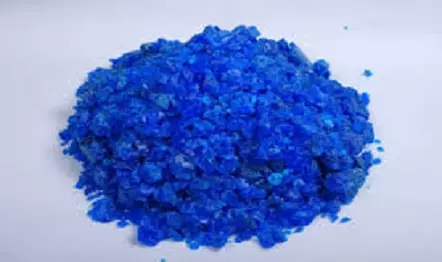IUPAC Name
Copper(II) sulfate
Cas Number
7758-99-8
HS Code
2833.25.00
Formula
CuSO4
Appearance
Blue Crystal
Common Names
Blue vitriol, Blue store
Packaging
25 Kg Bag
Brief Overview
Copper Sulfate generally refers to the sulfate salts of copper: Copper (I) sulfate and copper (II) sulfate. It is soluble in water but insoluble in alcohol. Anhydrous copper sulfate is a white crystalline solid, while the hydrated salt is blue. Prepared by the treatment of copper oxides with sulfuric acid, it is commercially available as a pentahydrate compound containing five molecules of water (CuSO4.5H2O) and is known in commerce as blue vitriol. Copper sulfate, blue stone, blue vitriol are all common names for pentahydrate cupric sulfate, which is the best known and most widely used of the copper salts.
Cupric sulfate is the most important copper salt, utilized mainly for agricultural and chemical industries. It also finds wide use in medicine and pigment industries.
Manufacturing process
In the production of copper sulfate, virgin copper is seldom used as the starting raw material. Copper ores are used in countries where they are mined. For the bulk of the world’s production, non-ferrous scrap is the raw material used. The scrap is refined and the molten metal poured into water to produce roughly spherical porous pieces about the size of marbles which are termed “shot”. This shot is dissolved in dilute sulfate acid in the presence of air to produce hot saturated liquor which, if the traditional large crystals of copper sulfate are required, is allowed to cool slowly in large cooling vats into which large cooling vats into which strips of lead are hung to provide a surface for the crystals to grow on. If the granulated crystal grades are desired, the cooling process is accelerated by agitating the liquor in water cooled vessels.
Other methods of production are:
1. By heating copper scrap with sulfur to produce copper sulfide which is then oxidized to form copper sulfate.
2. By heating copper sulfide ores to produce copper oxide which is then treated with sulfuric acid to form copper sulfate.
3. By slow leaching in air of piles of low grade ore. Bacterial action is sometimes employed to hasten the process. A solution of copper sulfate drains away from such heaps.
Agriculture Industry
The pentahydrate salt of copper sulfate is used as a fungicide. Together with lime, copper sulfate makes up the Bordeaux mixture, used to control fungus on grapes and other berries. As an herbicide, it helps control invasive exotic aquatic plants and the roots of other invasive plants near various pipes that contain water. A dilute copper sulfate solution is used to treat various parasitic infections in aquarium fish, remove snails from aquariums, or control algae population.
Mining Industry
It is used as a flotation reagent in the concentration of ores. Copper sulfate exhibits an activating effect on the flotation of sphalerite. It acts directly on the mineral surface, increase the selectivity of collector adherence to the surface of sphalerite, increase the strength of the adherence, reduce the amount of collector used, and impart optimum stability to the mineralized froth.
Metallurgy Industry
Copper sulphate is used in copper production during electro-winning and electro-refining. Both processes use electroplating on a large scale and are important techniques for the economical and straightforward purification of high purity copper.
Other applications
Copper sulfate also functions as a catalyst in some organic syntheses and as a reagent in various analytical tests, It is used as a mordant in dyeing Reagent in tanning processes. It is used to etch zinc plates for intaglio printmaking.
